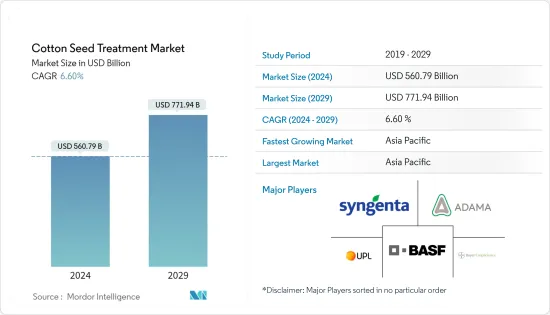 |
市场调查报告书
商品编码
1432875
棉籽加工:市场占有率分析、产业趋势/统计、成长预测(2024-2029)Cotton Seed Treatment - Market Share Analysis, Industry Trends & Statistics, Growth Forecasts (2024 - 2029) |
||||||
※ 本网页内容可能与最新版本有所差异。详细情况请与我们联繫。
棉籽加工市场规模预计到2024年为5,607.9亿美元,预计到2029年将达到7,719.4亿美元,在预测期(2024-2029年)成长6.60%,复合年增长率预计为

主要亮点
- 过去十年,基因改造棉花杂交品种的采用发生了巨大变化。 2018年,美国种植了506万公顷基因改造棉花。在印度,几乎 92% 的棉花面积都种植基因改造棉花。基因改造棉花的普及增加了棉籽加工产品在商业领域的使用。
- 杀菌剂是棉花种子处理产品的主要类别。影响棉苗的主要真菌病原体包括丝核菌、青霉、腐霉和镰刀菌。
棉籽加工市场趋势
更高的功效将导致杀菌剂领域的成长
透过种子处理可以轻鬆控制棉花的早期真菌病害。棉花早期可防治的主要真菌病原菌包括镰刀菌属、丝核菌属、长蠕孢菌属、腐霉属、疫霉属及拟梭霉属。昆虫是棉花作物最具破坏性的害虫,但人们发现,透过种子处理可以更有效地控製作物早期的真菌病害。用于棉籽处理的最常见的杀菌剂包括Azoxystrobin、Difenoconazole、FLUDIOXONIL、Metalaxyl和Myclobutanil。这些杀菌剂主要合併使用以广谱控制多种病原体。杀菌剂种子处理产品有效性的提高预计将推动棉籽处理市场杀菌剂市场的发展。
亚太地区引领全球市场
印度、中国和巴基斯坦是亚太地区棉花种植最多的国家。印度种植棉花面积超过 1,220 万公顷。到2014年,印度基改棉花的普及已接近92%。这使得印度成为世界上最大的棉花生产国和原棉出口国。基因改造棉花的采用也意味着棉花商业种子处理行业在审查期间取得了巨大增长。亚太市场的特点是既有大型跨国公司,也有规模较小的区域参与者。活跃于该地区市场商业领域的公司将为种子公司提供一系列产品,这些产品可以对在作物的前 15 至 20 天内侵染棉花的几乎所有病原体和害虫进行广谱控制。我更加强调在上面。
棉籽加工产业概况
棉籽加工市场高度整合,主要企业占了相当大的市场份额。这些公司不断增长的市场占有率可归因于其高度多元化的产品系列以及大量的收购和协议。此外,这些公司也专注于研发、产品系列扩展、地理足迹和积极的收购策略。该市场的主要企业包括BASF股份公司、先正达股份公司、安道麦农业解决方案公司、UPL 有限公司和拜耳作物科学股份公司。
其他福利
- Excel 格式的市场预测 (ME) 表
- 3 个月分析师支持
目录
第一章 简介
- 研究假设和市场定义
- 调查范围
第二章调查方法
第三章执行摘要
第四章市场动态
- 市场概况
- 市场驱动因素
- 市场限制因素
- 波特五力分析
- 供应商的议价能力
- 买方议价能力
- 新进入者的威胁
- 替代品的威胁
- 竞争公司之间敌对关係的强度
第五章市场区隔
- 化学来源
- 合成
- 生物来源
- 产品类别
- 杀虫剂
- 杀菌剂
- 其他产品类型
- 目的
- 农场
- 商务用
- 地区
- 北美洲
- 美国
- 加拿大
- 墨西哥
- 其他北美地区
- 欧洲
- 德国
- 英国
- 法国
- 西班牙
- 俄罗斯
- 义大利
- 其他欧洲国家
- 亚太地区
- 中国
- 印度
- 日本
- 澳洲
- 其他亚太地区
- 南美洲
- 巴西
- 阿根廷
- 南美洲其他地区
- 非洲
- 南非
- 其他非洲
- 北美洲
第六章 竞争形势
- 最采用的策略
- 市场占有率分析
- 公司简介
- BASF SE
- Bayer Crop Science AG
- Syngenta AG
- Adama Agricultural Solutions
- UPL Limited
- Advanced Biological Marketing Inc.
- Corteva Agriscience
- Incotec Group BV
- Valent USA Corporation
第七章 市场机会及未来趋势
The Cotton Seed Treatment Market size is estimated at USD 560.79 billion in 2024, and is expected to reach USD 771.94 billion by 2029, growing at a CAGR of 6.60% during the forecast period (2024-2029).

Key Highlights
- The last decade has witnessed a dramatic shift in the adoption of genetically modified cotton hybrids. In 2018, the United States planted 5.06 million hectares of GM cotton. In India, almost 92% of the cotton area cultivates GM cotton. The widespread adoption of GM cotton has resulted in increased usage of cotton seed treatment products in the commercial segment.
- Fungicides are the major category of seed treatment products used in cotton. The major fungal pathogens affecting young cotton plants include Rhizoctonia spp., Penicillium spp., Pythium spp., and Fusarium spp., among others.
Cotton Seed Treatment Market Trends
Higher Efficacy Leading to Growth of the Fungicides Segment
Early-stage fungal diseases in cotton can easily be controlled using seed treatment. The major fungal pathogens that can be controlled in early-stage cotton include Fusarium, Rhizoctonia, Helminthosporium, Pythium, Phytophthora, and Thielaviopsis. Although insects are the most damaging pests to cotton crop, fungal diseases at the early stages of the crop have found greater control through seed treatment. Some of the most popular fungicides used in the seed treatment of cotton are Azoxystrobin, Difenoconazole, Fludioxonil, Metalaxyl, and Myclobutanil, among others. These fungicides are used mostly in combinations to provide broad-spectrum control to more than one pathogen. The increased efficacy of fungicidal seed treatment products is expected to drive the market for the fungicide segment of the cotton seed treatment market.
Asia-Pacific Leads the Global Market
India, China, and Pakistan are the countries that cultivate a majority of cotton in the Asia-Pacific region. Cotton is grown over 12.2 million hectares in India. By the year 2014, India had achieved almost 92% penetration of genetically modified cotton. This has led to India being the top cotton producer and raw cotton exporter in the world. The adoption of GM cotton also means that the segment of commercial seed treatment in cotton has grown phenomenally over the review period. The Asia-Pacific market is characterized by the presence of large multinationals as well as smaller regional players active in the market. Companies active in the commercial segment of the market in the region are increasingly focusing on providing seed companies with product combinations, which provide broad spectrum control to almost all the pathogens and pests that infest cotton for the first 15-20 days of the crop.
Cotton Seed Treatment Industry Overview
The cotton seed treatment market is highly consolidated, with the top global players occupying large shares in the market. The greater market shares of these players can be attributed to highly diversified product portfolio and numerous acquisitions and agreements. Moreover, these players are focusing on R&D, expansion of product portfolio, wide geographical presence, and aggressive acquisition strategies. Some of the key players in the market include BASF SE, Syngenta AG, Adama Agricultural Solutions, UPL Limited, and Bayer Crop Science AG.
Additional Benefits:
- The market estimate (ME) sheet in Excel format
- 3 months of analyst support
TABLE OF CONTENTS
1 INTRODUCTION
- 1.1 Study Assumptions and Market Definition
- 1.2 Scope of the Study
2 RESEARCH METHODOLOGY
3 EXECUTIVE SUMMARY
4 MARKET DYNAMICS
- 4.1 Market Overview
- 4.2 Market Drivers
- 4.3 Market Restraints
- 4.4 Porter's Five Forces Analysis
- 4.4.1 Bargaining Power of Suppliers
- 4.4.2 Bargaining Power of Buyers
- 4.4.3 Threat of New Entrants
- 4.4.4 Threat of Substitute Products
- 4.4.5 Intensity of Competitive Rivalry
5 MARKET SEGMENTATION
- 5.1 Chemical Origin
- 5.1.1 Synthetic
- 5.1.2 Biological
- 5.2 Product Type
- 5.2.1 Insecticides
- 5.2.2 Fungicides
- 5.2.3 Other Product Types
- 5.3 Application
- 5.3.1 On-farm
- 5.3.2 Commerical
- 5.4 Geography
- 5.4.1 North America
- 5.4.1.1 United States
- 5.4.1.2 Canada
- 5.4.1.3 Mexico
- 5.4.1.4 Rest of North America
- 5.4.2 Europe
- 5.4.2.1 Germany
- 5.4.2.2 United Kingdom
- 5.4.2.3 France
- 5.4.2.4 Spain
- 5.4.2.5 Russia
- 5.4.2.6 Italy
- 5.4.2.7 Rest of Europe
- 5.4.3 Asia-Pacific
- 5.4.3.1 China
- 5.4.3.2 India
- 5.4.3.3 Japan
- 5.4.3.4 Australia
- 5.4.3.5 Rest of Asia-Pacific
- 5.4.4 South America
- 5.4.4.1 Brazil
- 5.4.4.2 Argentina
- 5.4.4.3 Rest of South America
- 5.4.5 Africa
- 5.4.5.1 South Africa
- 5.4.5.2 Rest of Africa
- 5.4.1 North America
6 COMPETITIVE LANDSCAPE
- 6.1 Most Adopted Strategies
- 6.2 Market Share Analysis
- 6.3 Company Profiles
- 6.3.1 BASF SE
- 6.3.2 Bayer Crop Science AG
- 6.3.3 Syngenta AG
- 6.3.4 Adama Agricultural Solutions
- 6.3.5 UPL Limited
- 6.3.6 Advanced Biological Marketing Inc.
- 6.3.7 Corteva Agriscience
- 6.3.8 Incotec Group BV
- 6.3.9 Valent USA Corporation









